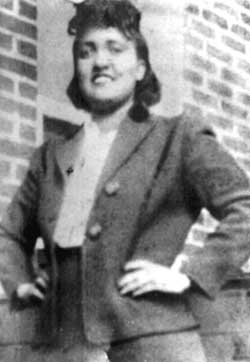Sunday, August 14, 2011
August 14, 2011 : Henrietta Lacks - Immortal Cells
Henrietta Lacks (August 1, 1920 – October 4, 1951) (sometimes erroneously called Helen Lane or Helen Larson) was an African American woman who was the unwitting source of cells from her cancerous tumor, which were cultured by George Otto Gey to create an immortal cell line for medical research. This is now known as the HeLa cell line.
The cells from Henrietta's tumor were given to researcher George Gey, who "discovered that [Henrietta's] cells did something they'd never seen before: They could be kept alive and grow." Before Henrietta, the cells would only survive for a few days. Scientists spent more time trying to keep the cells alive than performing actual research on the cells. Some cells in Lacks's tissue sample behaved differently than others. George Gey was able to isolate one specific cell, multiply it, and start a cell line. Gey named the sample "HeLa," after the initial letters of Henrietta Lacks' name, to protect her identity. As the first human cells that could be grown in a lab were "immortal" (did not die after a few cell divisions), they could then be used for conducting many experiments. This represented an enormous boon to medical and biological research.
As reporter Michael Rogers stated, the growth of HeLa by a researcher at the hospital helped answer the demands of the 10,000 who marched for a cure to polio just shortly before Lacks' death. By 1954, HeLa was being used by Jonas Salk to develop a vaccine for polio. To test Salk's new vaccine, the cells were quickly put into mass production in the first-ever cell production factory.
Demand for the HeLa cells quickly grew. Since they were put into mass production, Henrietta's cells have been mailed to scientists around the globe for "research into cancer, AIDS, the effects of radiation and toxic substances, gene mapping, and countless other scientific pursuits". HeLa cells have been used to test human sensitivity to tape, glue, cosmetics, and many other products. Scientists have grown some 20 tons of her cells.
Doctors still have not discovered the reason for HeLa cells' unique vigor, but suspect that it is due to altered telomerase function. There are almost 11,000 patents involving HeLa cells.
In the early 1970s, the family started getting calls from researchers who wanted blood samples from them to learn the family's genetics (eye colours, hair colours, and genetic connections). The family wondered why and this is when they learned about the removal of Henrietta's cells. No one else in the family had the traits that made her cells unique.
Source
Labels:
August 2011,
Incredible,
Interesting
Subscribe to:
Post Comments (Atom)


No comments:
Post a Comment